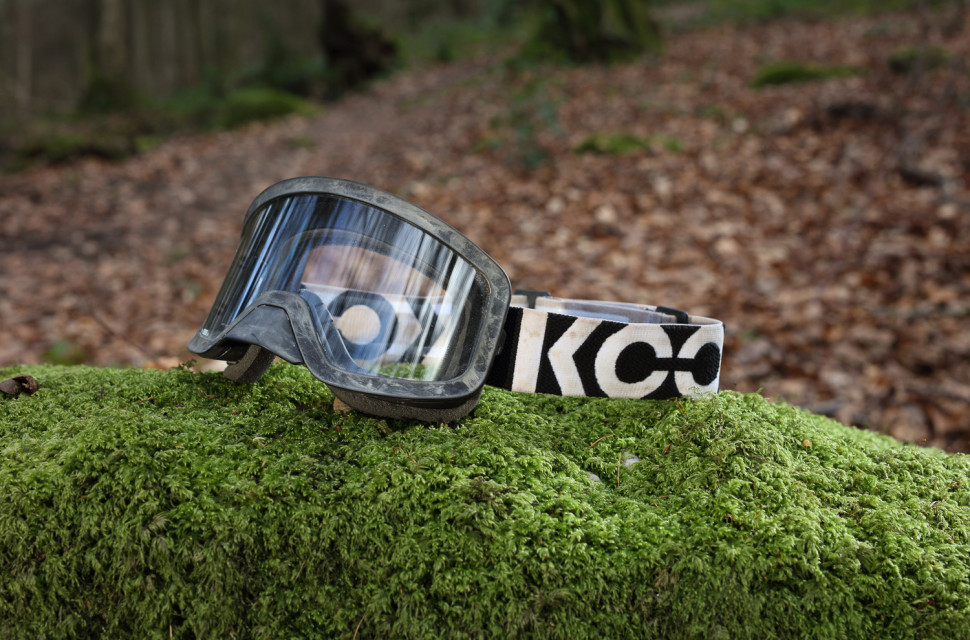
- Zeiss lens offers excellent clarity and durability
- Very expensive compared to rivals
- Quick release lens released too easily on my test set
- Not very comfortable or secure, prone to fogging up
KOO is the sister eyewear brand to helmet manufacturer Kask and the Edge is their first mountain bike goggle. The Zeiss lens offers excellent clarity, but they fog up very easily, the frame shape and padding wasn't that secure or comfortable and they're very expensive. The quick-release lens system on our test goggles also led to them popping out of place annoyingly.
- Ten top tips for Alpine riding trips
- The best mountain bikes you can buy for under £1,500 - full sus and hardtails
- Buyers guide to mountain bike tyres - get the best rubber for your MTB
The Edge goggles get a high-quality Zeiss lens; a brand often associated with top-end photography kit. It's certainly a worthwhile investment here as the clear lens versions I used gave excellent vision and clarity in low light along with very little optical distortion noticeable. It also proved to be pretty tough and scratch-resistant, despite mucky winter use and abuse.
Sadly, the lens is very much the high point, as the rest of the goggles are a letdown. While the Edges use dual-density foam to help seal against your face, as do most other high-end goggles, they lack the thin wicking outer layer seen on many of those. That means there's nothing soft against your skin apart from bare foam, which is uncomfortable in extended use and also poor at wicking away sweat.
I also didn't get along with the overall shape either, finding that they didn't seal very well around my nose and also moved around a fair bit in use. The strap didn't help here; it might have two lines of silicone gripper but it's not broad or as fiercely stretchy as other high-priced goggles.
I also had issues with the quick-release lens system. This uses L shaped hooks the lens that slot into the google body, with a clip at one end to secure everything. It does allow relatively fast lens changes with minimal finger smearing when you get used to it by sliding the lens along and then clipping in, but I found that it was pretty easy for the lens to pop out of the securing slots, especially if you pulled the goggles on or off with one hand, twisting the body in the process.
I think the issue here is the relatively rigid lens just doesn't twist as much as the more flexible goggle body, leading to the hooks hopping out of the slots at the non-clip end and much annoyance as you have to remove the lens fully to get it seated back in.
I spoke to KOO about this and they said: "We developed the EDGE goggle thinking of a simple and effective way to replace lenses. This system relies on L shaped sliding pins that lock the lens and its cover into the goggle frame. If the lens pops out when deforming the frame (for example when trying to pull the goggle on the helmet one-handed), it might mean that the cover is not perfectly engaged."
The lens also lacks tear-off studs, which isn't a deal-breaker for my riding by any means; it also removes them as a visual impediment. KOO has developed a scratch-resistant and re-useable protective film that would function much like a re-usable tear-off, which looks to be an interesting and more environmentally friendly innovation. There is also a removable nose guard included as standard for those that want one
More of a critical issue was the fogging, which was quick to form but slow to disappear. While there are foam covered ventilation holes along both the top and bottom of the goggles, the individual holes in the frame are relatively small compared to most other brands, with a resulting lack of airflow meaning they just can't get rid of humid air inside the goggles fast enough, even when riding at speed.
It's very hard to recommend these goggles as they stand. While the lens popping issue might have been a one-off annoyance with my test set, the constant steaming up and lack of comfort are poor, especially as they're twice the price of perfectly functional goggles that might lack the clarity of the lens, but exceed them everywhere else.














Add comment